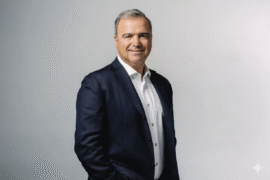This article may contain references to products or services from one or more of our advertisers or partners. We may receive compensation when you click on links to those products or services. Nonetheless, our opinions are our own.
The information presented in this article is accurate to the best of our knowledge at the time of publication. However, information is subject to change, and no guarantees are made about the continued accuracy or completeness of this content after its publication date.
- Starting Your Investment Journey
- The Value of Investing for Long-Term Financial Health
- Clarifying Goals and Risk Comfort Levels
- Choosing Accounts That Support Growth
- Exploring Available Investment Types
- Building a Balanced Portfolio
- Monitoring Progress and Staying Informed
- Starting with Confidence
- Frequently Asked Questions
- Recommended Reads
Starting Your Investment Journey
Starting to invest can feel unfamiliar at first, especially for those without financial experience. With thoughtful planning, a clear understanding of available options, and a steady approach, investing becomes a practical and rewarding path toward financial security. This introduces time-tested strategies, account types, and asset classes tailored to individuals beginning their investment journey, offering clarity and direction without unnecessary complexity.
The Value of Investing for Long-Term Financial Health
Investing involves placing money into assets with the expectation of future growth or income. Unlike traditional savings accounts, which may earn minimal interest, investments offer the opportunity for wealth accumulation over time. Growth is achieved through appreciation, dividends, or interest. Investing early, even in modest amounts, can help counter the effects of inflation and build a foundation for long-term financial goals such as retirement, property purchases, or education funding.
Benefits of Investing
- Asset growth: Over time, investments may increase in value, leading to higher returns
- Inflation protection: Investment returns can outpace inflation, maintaining purchasing power
- Financial milestones: Investing supports long-range planning for major life objectives
Clarifying Goals and Risk Comfort Levels
Before selecting an investment, it is important to define what outcomes are expected. Financial objectives can be short-range, such as saving for a car, or long-range, such as preparing for retirement. Aligning investments with both timelines and tolerance for potential losses ensures decisions are made with clarity and confidence.
Common Financial Objectives
- Retirement preparation
- Emergency fund growth
- Real estate purchase
- Education savings
- Generating income through interest or dividends
Choosing Accounts That Support Growth
Selecting an account type is an important step, as it determines how earnings are taxed and how funds can be accessed. Accounts such as Individual Retirement Accounts (IRAs) and 401(k) plans offer tax advantages and are suited to long-term investing. Standard brokerage accounts, though not tax-sheltered, allow for more flexibility and immediate access to funds.
| Account Type | Tax Benefits | Withdrawal Conditions |
|---|---|---|
| IRA | Tax-deductible or tax-free | Early withdrawal penalties |
| 401(k) | Employer match potential | Restrictions before age 59½ |
| Brokerage Account | No tax shelter | Free access without penalties |
Combining different accounts can create balance, offering both flexibility and tax efficiency. Young investors often begin with a tax-advantaged plan and supplement it with a general brokerage account.
Voted "Best Overall Budgeting App" by Forbes and WSJ
Monarch Money helps you budget, track spending, set goals, and plan your financial future—all in one app.
Get 50% OFF your first year with code MONARCHVIP
Exploring Available Investment Types
 A successful investment strategy begins with understanding the different asset classes and how they function.
A successful investment strategy begins with understanding the different asset classes and how they function.
Major Investment Vehicles
- Stocks: Represent ownership in companies. Returns are typically higher but fluctuate based on market and company performance.
- Bonds: Fixed-income securities issued by governments or corporations. Offer more stability and consistent income.
- Mutual Funds: Pooled assets from multiple investors, professionally managed across various securities.
- ETFs (Exchange-Traded Funds): Similar to mutual funds but trade like stocks, often with lower fees.
- Real Estate: Involves property investment with potential for rental income and appreciation.
Building a Balanced Portfolio
A diversified portfolio reduces exposure to risk by spreading investments across different asset types. Allocation depends on time horizon, income needs, and risk preferences.
Example of a Balanced Allocation
| Asset Type | Allocation Percentage |
|---|---|
| Stocks | 60% |
| Bonds | 30% |
| Real Estate | 5% |
| Cash & Equivalents | 5% |
Periodic rebalancing ensures that the portfolio remains aligned with original targets and risk appetite, particularly after market movements or life changes.
Monitoring Progress and Staying Informed
Ongoing success in investing relies on maintaining awareness and making adjustments when necessary. Economic shifts, personal milestones, and regulatory changes can all influence investment decisions.
Recommended Practices
- Review asset performance quarterly or annually
- Stay informed through trusted financial publications
- Track holdings and returns over time
- Adjust allocations as goals or market conditions evolve
Recording progress in this way provides a clearer picture of overall growth and supports well-informed decision-making.
Starting with Confidence
Beginning an investment journey does not require large sums or advanced knowledge. With a thoughtful approach, careful goal setting, and a basic understanding of investment types and strategies, anyone can begin to build a more secure financial future. Starting with modest contributions and increasing them over time builds not only financial strength but also confidence. Investment success is rooted in patience, discipline, and consistent learning.
Frequently Asked Questions
What is investing and why is it useful?
Investing refers to allocating money into assets to generate returns over time. It offers a path to build wealth and meet long-term financial objectives.
How much money is required to begin?
Some platforms allow entry with as little as $50 or $100. What matters most is consistency, not the initial amount.
What types of investments are available?
Common categories include stocks, bonds, ETFs, mutual funds, and real estate, offering different levels of risk and return.
How do I decide where to invest?
Investment choices should align with personal goals, risk preferences, and timeline. Independent research and professional advice can support decision-making.
Why is diversification important?
Distributing funds across various assets lowers exposure to individual market risks and supports more stable growth.
How often should investments be reviewed?
Annual or semi-annual reviews are generally sufficient. Adjust when there are significant life changes or economic shifts.

Reviewed and edited by Albert Fang.
See a typo or want to suggest an edit/revision to the content? Use the contact us form to provide feedback.
At FangWallet, we value editorial integrity and open collaboration in curating quality content for readers to enjoy. Much appreciated for the assist.
Did you like our article and find it insightful? We encourage sharing the article link with family and friends to benefit as well - better yet, sharing on social media. Thank you for the support! 🍉
Article Title: How to Start Investing: A Beginner’s Guide
https://fangwallet.com/2025/05/26/beginner-investment-guide/The FangWallet Promise
FangWallet is an editorially independent resource - founded on breaking down challenging financial concepts for anyone to understand since 2014. While we adhere to editorial integrity, note that this post may contain references to products from our partners.
The FangWallet promise is always to have your best interest in mind and be transparent and honest about the financial picture.
Become an Insider

Subscribe to get a free daily budget planner printable to help get your money on track!
Make passive money the right way. No spam.
Editorial Disclaimer: The editorial content on this page is not provided by any of the companies mentioned. The opinions expressed here are the author's alone.
The content of this website is for informational purposes only and does not represent investment advice, or an offer or solicitation to buy or sell any security, investment, or product. Investors are encouraged to do their own due diligence, and, if necessary, consult professional advising before making any investment decisions. Investing involves a high degree of risk, and financial losses may occur including the potential loss of principal.
Source Citation References:
+ Inspo
There are no additional citations or references to note for this article at this time.












































